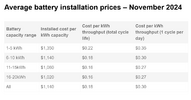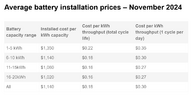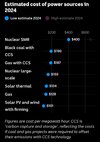- Nov 10, 2022
- 15,367
- 12,900
- AFL Club
- Hawthorn
Getting a look at once flowing water on mars should have been a huge wake-up call to us
Follow along with the video below to see how to install our site as a web app on your home screen.
Note: This feature may not be available in some browsers.
Due to a number of factors, support for the current BigFooty mobile app has been discontinued. Your BigFooty login will no longer work on the Tapatalk or the BigFooty App - which is based on Tapatalk.
Apologies for any inconvenience. We will try to find a replacement.
Due to a number of factors, support for the current BigFooty mobile app has been discontinued. Your BigFooty login will no longer work on the Tapatalk or the BigFooty App - which is based on Tapatalk.
Apologies for any inconvenience. We will try to find a replacement.
Getting a look at once flowing water on mars should have been a huge wake-up call to us
The levelized cost of storage (LCOS) is a way to compare the economic costs of different storage technologies. It's calculated by dividing the total life cycle cost of a system by its total lifetime energy production.
$200 per KWH /4000 cycles = 5cents KWH
Now that 4000 cycles is not its end of life but it’s a standard assumption.
Getting a look at once flowing water on mars should have been a huge wake-up call to us
Log in to remove this Banner Ad
In your mind …..But you and I both no what you’re representing is false
That’s why you won’t address the questions presented
Riiiiight. So we're talking about the science here. Those bloody environmentally reckless martians.
In your mind …..
Gencost have similar figures to my beer coaster figures, so can you explain how my figures are wrong????
It’s not rocket science….
“It's calculated by dividing the total life cycle cost of a system by its total lifetime energy production.”
Also you can’t calculate the cost of solar or wind or battery on their own…. It’s actually pointless.
It’s like calculating hydro with out water.
Larger scale batteries upfront cost is between $80USD and $250USD per KWH…
Life cycles = life time production.
… I’m sure you can work out the rest.
charging them up using Solar is so cheap it’s hardly worth adding it to the cost..
The fact we are discussing cost is pretty stupid… and deciding what’s more profitable is the most insane thing …
We really are the most stupidest animals on the planet… a cancer on the planet.
…. And even when we are provided the most cost affective and environmentally friendly source of electricity.. there are still twits that dont believe it.
In your mind …..
Gencost have similar figures to my beer coaster figures, so can you explain how my figures are wrong????
It’s not rocket science….
“It's calculated by dividing the total life cycle cost of a system by its total lifetime energy production.”
Also you can’t calculate the cost of solar or wind or battery on their own…. It’s actually pointless.
It’s like calculating hydro with out water.
Larger scale batteries upfront cost is between $80USD and $250USD per KWH…
Life cycles = life time production.
… I’m sure you can work out the rest.
charging them up using Solar is so cheap it’s hardly worth adding it to the cost..

Lets put cost and profit to one side and focus on the environmental impact, specifically, as you point out, the amount of CO2 produced per energy source. If we are serious about stopping global warming, then we need to go wind and nuclear. They have the lowest gCO2/KWh.
Wind 11g
Nuclear 12g
Tidal 22g
Hydropower 24g
Solar Energy 41g
Biomass 230g
Natural Gas 450g
Coal 910g
80% …What efficiency rate?
5%What discount rate?
Batteries have reduce 97% in the last three decades.What inflation rate?
It’s included in the capital costsWhat installation cost?
What servicing costs?
Basically instant… depending on the grid.What utilisation rate?
Having a decentralised grid will reduce the capacity factor and strengthen grid resistance..What capacity factor?
What does groups who use BESS claim as cost based on actual reality rather conceptual?
80% …
5%
Batteries have reduce 97% in the last three decades.
It’s included in the capital costs
Bugger all compared to any other energy source.
Basically instant… depending on the grid.
Having a decentralised grid will reduce the capacity factor and strengthen grid resistance..
Refer Gencost .. Lazards…

Lets put cost and profit to one side and focus on the environmental impact, specifically, as you point out, the amount of CO2 produced per energy source. If we are serious about stopping global warming, then we need to go wind and nuclear. They have the lowest gCO2/KWh.
Wind 11g
Nuclear 12g
Tidal 22g
Hydropower 24g
Solar Energy 41g
Biomass 230g
Natural Gas 450g
Coal 910g
I’m assuming you are assuming that because 95% of Solar is produced in china, and they have a high % of coal in its grid, that’s how you get 41g.
So as chinas grid gets greener .. currently 36%… and mines go electric etc… this figure will continue to fall…
Solar panels once built dont produce CO2.
Per day is irrelevant… but at the moment I am cycling my system from 100% to 10% and averaging $12 a day credit… about $10 a day after day rate and Amber subscription.View attachment 2184835
do you get one full cycle per day out of your batteries at home? is $0.35 too low for your installation?
So the catastrophe wasn’t Martian- made.. sure I see the difference
Per day is irrelevant… but at the moment I am cycling my system from 100% to 10% and averaging $12 a day credit… about $10 a day after day rate and Amber subscription.
I’ll do the numbers for the 5th time…
$16000/19.2=$833.33 per kWh
$833/4000cycles =$0.21 cents
So I’ve got no idea how you can come up with higher costs for large scale commercial batteries.
You really don't understand our existence.
We're like a bunch of tadpoles living in a deep puddle on the edge of a freeway.
We just happen to live in a world with oxygen and water.
Its pure luck that all the water isn't frozen, and the oxygen is mixed in an atmosphere we can breathe.
The planet has changed temperature a lot, but freakishly it has remained fairly constant for maybe 10 000 years, during which our civilization has happened.
Add infinite planets in existence , and there is plenty of life elsewhere. But it was never Mars and your discussion of mars is totally irrelevant to the current discussion.
1) you are referring to an arbitrage rather than a cost These are very different concepts.
2) home use you come up with $0.21 whilst the installers come up with $0.35 but regardless both numbers are in line with the $0.24 to $0.40 range I presented
3) The commercial scale has the advantage of subsidies, scale and optimisation (regular tweaks to the control system and pull in pull out) but have the cost of land, buildings, EPC, finance, lawyers, operators, insurance, permits and the holding costs awaiting connection (especially if connected to the grid). I travelled through China with BESS operators globally (Oz, SAfr, Israel, US, EU etc) including to CATL and they all said $0.24 to $0.40. Remember commercial scale is just more of the little cells that make up your unit.
I agree batteries are improving and solid state will be the giant leap required as this not only = better performance but as I understand means no PFAS.

1) you are referring to an arbitrage rather than a cost These are very different concepts.
So my home battery is cheaper than large scale… rightio. According to you and your mates…
Yet Gencost and lazards have firm renewables… Solar and battery together at under $200 a megawatt …
Please just stop.
View attachment 2184859
with firming includes gas
and are these numbers from the Gencost Report you posted links to discrediting?
Firming is STORAGE !!!!! seriously are you being deliberately stupid?
